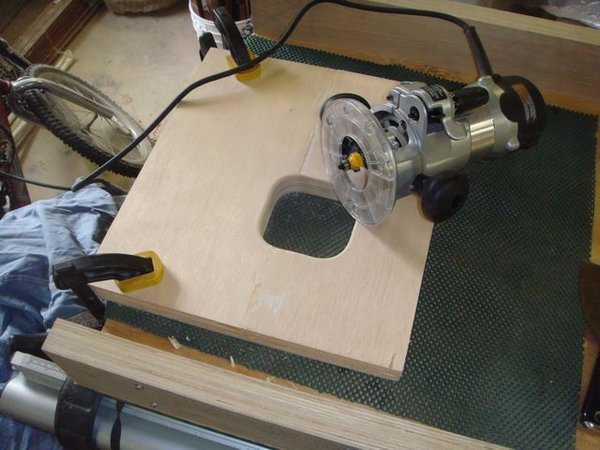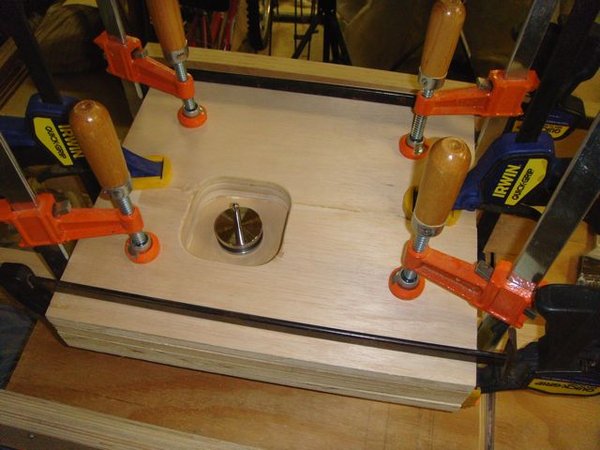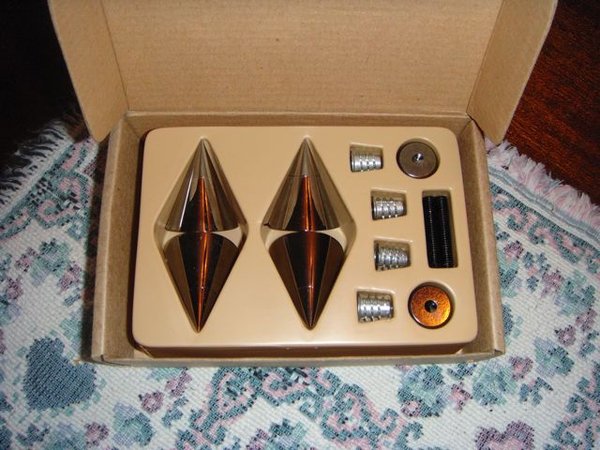Plinth, Part 2
Only the top two plywood layers supported the bearing (remember, the bearing was designed for a 1½” plate), so the bottom two layers needed an access hole cut to allow my hand in to tighten the torque nut. On the bottom two plates, I laid out a 4” square centered on the bearing location (remember to measure twice, cut once!). I drilled four 1” holes centered ½“ in from the square’s sides at each corner, and cut out the square with a saber saw. On the bottom plate, I routed the edge of the square using a 3/8“ round-over bit with guide bearing to make the edge smooth (see Figure 7).
Attachment:
File comment: Figure 7: Route Outer Edges of Access Hole
 Route Outer Edges of Access Hole.jpg [ 54.83 KiB | Viewed 48484 times ]
Route Outer Edges of Access Hole.jpg [ 54.83 KiB | Viewed 48484 times ]
All four pieces were glued together using normal yellow wood glue and a wood-glue applicator roller, as shown in Figure 8. The roller applied a thin, even layer of glue between each piece. I used a factory-cut edge to line up the panels – the other edges were later trimmed to be even. Once all four pieces were stacked together, I put the bearing in the holes in the top two pieces to line up the hole. I then clamped the four pieces together, removed the bearing, and made sure to clean off any glue from the bearing. You can never use too many clamps!
Attachment:
File comment: Figure 8: Glue and Clamp Four Plinth Piece Together
 Glue Clamp Plinth Pieces Together.jpg [ 51.36 KiB | Viewed 48484 times ]
Glue Clamp Plinth Pieces Together.jpg [ 51.36 KiB | Viewed 48484 times ]
I had to provide a means to level the platter, and many people in the club swore by isolation spikes or cones to control vibration. If I could mount a trio of spikes (easier to level than four) on the bottom of the plinth, I could use them to level the platter and hopefully isolate the plinth from some vibration. I found a set of speaker spikes that were threaded to screw into a speaker at Parts Express (see Figure 9). I could replace the threaded studs with longer ones, drill holes through the plinth from top to bottom, and use a screwdriver to adjust the spikes from the top. You can see the mockup results in Figure 10 in the next posting. Look at the matte finish and bevel on the platter! I still used painters’ tape to locate measurements, and I tried to center the spikes immediately around the platter – two in the back and one in the front. This kept the spike adjustments out of the way of the tonearm, but I found that the plinth was very tipsy with this arrangement – the mass of the plinth was about the same as the mass of the platter and bearing. After seeking suggestions from club members, they pointed out that two spikes on the side facing the motor pod would stabilize the plinth against the pull of the belt, and the likely position of the third spike was opposite the first two. That’s the arrangement I used (see Figure 6), and it was much more stable than my first attempt. If you look in coming plinth figures, you can see where I plugged the first spike-mounting holes.
Attachment:
File comment: Figure 9: Threaded Speaker Spikes (Parts Express PN 240-715, DSS4-BC, $35.16 including shipping)
 Threaded Speaker Spikes.jpg [ 63.72 KiB | Viewed 48484 times ]
Threaded Speaker Spikes.jpg [ 63.72 KiB | Viewed 48484 times ]
The threaded rods I bought for the spikes were long enough to stick through the top of the plinth. Instead of trying to find a way to dress the rod holes and carry a screwdriver, I decided to top the rods with knurled handles and check nuts. I bought four sets (in case I lost one) from Carr Lane (through Novatool Inc. in Baltimore) for a total cost of $33.02. The parts were CLM-6-KK Knurled Knobs and CLM-6-TSJN Check Nuts, which were an inch around. Once the platter is leveled, I will hold the knobs and twist the check nuts down against the plinth top to hold the adjustment. I thought about super-gluing the knobs in place, but permanence scares me so I put locks nuts in the tops of the knobs and tightened them against the rods inside: Pretty and functional!
You can see in Figure 8 that the plinth edges toward the camera weren’t perfectly aligned. Once the glue was thoroughly dry, I ran the plinth block through a bench-top joiner to even out the edges. Figure 10 shows that the four sides were then smooth and ready for a dressing up with oak. Well, all accept for the back edge. When I ran the plinth through the joiner, I should have placed a sacrificial piece of lumber on the plinth top to prevent splintering: I didn’t, and it did!
Copyright 2012 Guy W. Riffle. All rights reserved.
|
